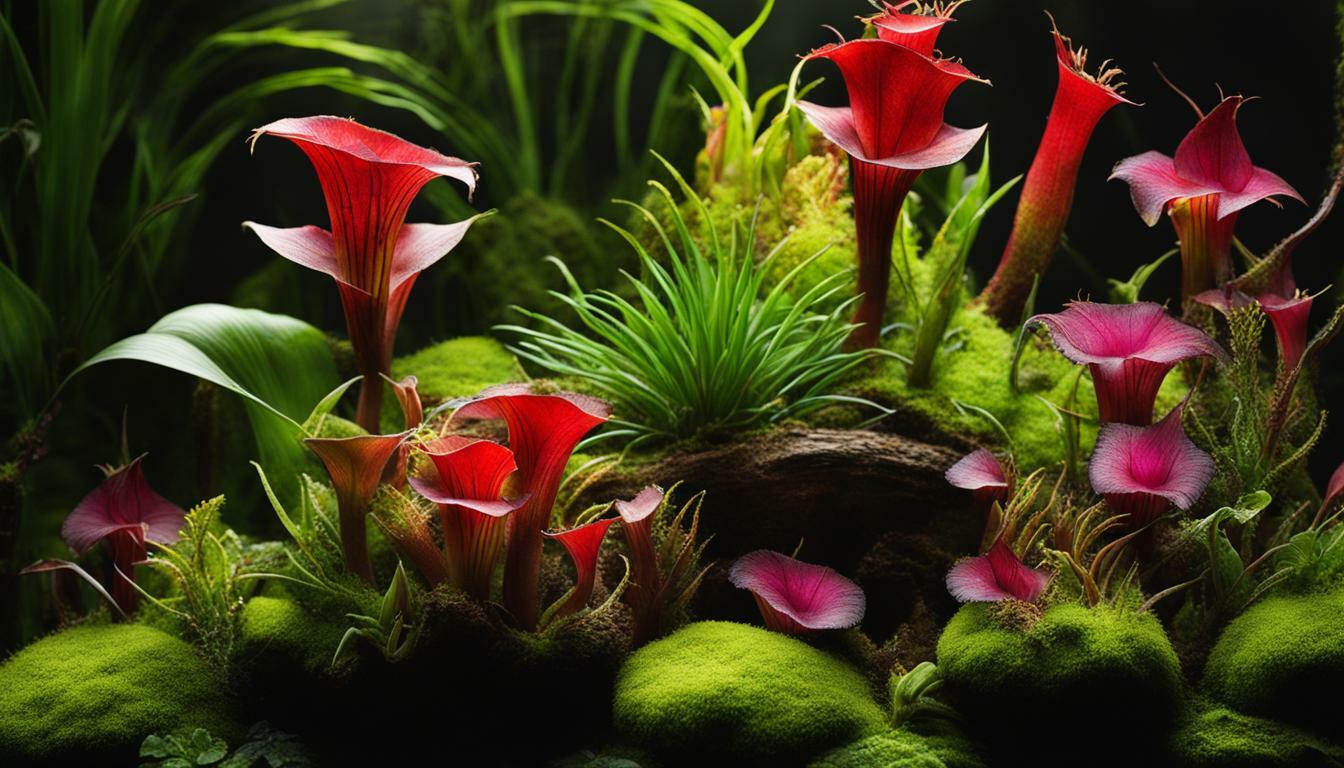Welcome to the world of terrarium plants, where carnivorous plants take center stage. These unique and captivating plants are a fascinating addition to any terrarium, bringing a touch of intrigue and beauty to your indoor garden. Carnivorous plants have evolved to survive in nutrient-poor environments by capturing and digesting insects. Their ability to attract, trap, and consume prey sets them apart from other plants, making them a captivating choice for plant enthusiasts.
- Carnivorous plants, such as sundews, pitcher plants, and butterworts, are popular choices for terrariums due to their unique characteristics.
- Choosing the right container and providing proper drainage is essential for creating a suitable environment for carnivorous plants in a terrarium.
- Carnivorous plants require a low-nutrient soil substrate and specific watering methods to thrive.
- Proper lighting is crucial for the growth and development of carnivorous plants in a terrarium.
- When selecting carnivorous plants for your terrarium, consider their care requirements and growth habits to ensure optimal conditions.
As we delve further into the world of terrarium plants, we will explore the various aspects of caring for and maintaining a carnivorous plant terrarium. From choosing the right container to setting up lighting and ongoing maintenance, we will provide you with the knowledge and guidance you need to create a thriving habitat for these fascinating plants.
Understanding Carnivorous Plants
Carnivorous plants are a fascinating and unique group of plants that require special care to thrive in a terrarium setting. These plants have adapted to nutrient-poor environments by developing ingenious methods to capture and digest insects and other small prey. Their carnivorous nature sets them apart from typical terrarium plants, adding a touch of intrigue and excitement to any indoor garden.
When it comes to caring for carnivorous plants in a terrarium, it’s important to understand their specific needs. Some popular carnivorous plants suitable for terrariums include sundews, pitcher plants, and butterworts. Each species has its own care requirements, but there are some general guidelines that apply to most carnivorous plants.
One crucial factor to consider when caring for carnivorous plants in a terrarium is the container. It’s important to choose a container that provides proper drainage to prevent waterlogging, as these plants require a consistently moist but not waterlogged environment. A terrarium with a lid or cover can help maintain the high humidity levels that carnivorous plants prefer.
| Carnivorous Plant | Preferred Light Levels |
|---|---|
| Sundews | Medium to Bright Indirect Light |
| Pitcher Plants | Bright Indirect Light |
| Butterworts | Medium to Bright Indirect Light |
Lighting is another crucial aspect of carnivorous plant care. These plants typically require more light than typical terrarium plants due to their need for photosynthesis and the energy required for trapping and digesting prey. If the natural lighting in your home is insufficient, you may need to supplement with artificial grow lights to ensure your carnivorous plants thrive.
“Carnivorous plants are not only fascinating to observe, but they also provide a natural means of pest control in your indoor garden.”
It’s worth noting that some carnivorous plant species, like the Venus Flytrap and American Pitcher Plants, may not be suitable for terrariums due to their specific care requirements and dormancy periods. These species often require a winter dormancy period and may have more specific temperature and humidity requirements.
Tips for Carnivorous Plant Care:
- Use distilled water or rainwater to prevent the buildup of mineral salts
- Feed your carnivorous plants with live or freeze-dried insects to supplement their nutrient needs
- Keep the terrarium clean by removing dead insects or debris
- Monitor the health of your plants regularly and address any signs of stress or disease promptly
By providing the right conditions and care, you can enjoy the captivating beauty of carnivorous plants in your terrarium while also benefiting from their natural pest control abilities.
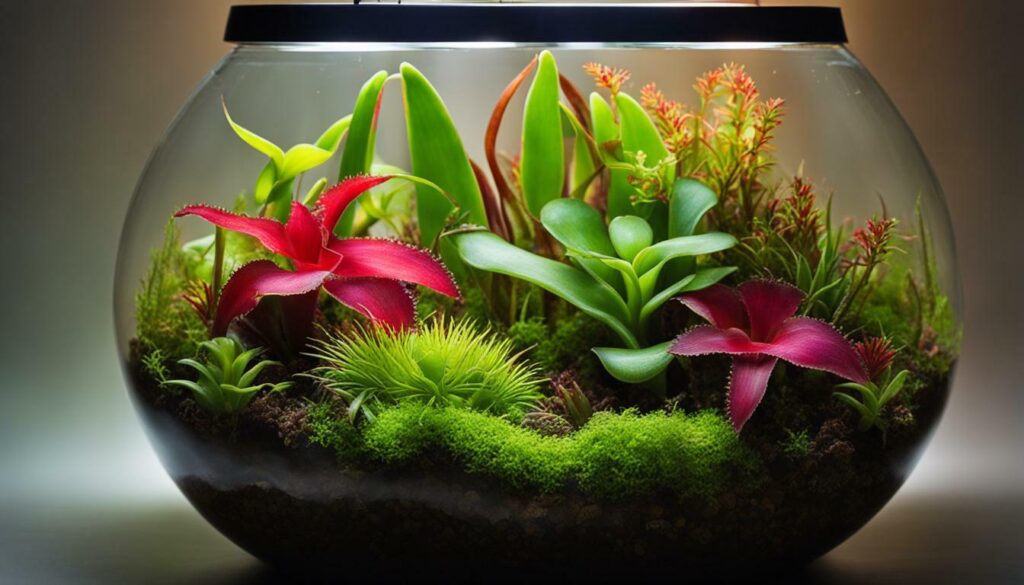
Selecting the right container is crucial when building a terrarium for carnivorous plants. These unique plants have specific care requirements, and their container plays a significant role in their overall health and growth. When considering a container for your carnivorous plant terrarium, there are a few key factors to keep in mind.
Firstly, size matters. Carnivorous plants come in various sizes, so it’s important to choose a container that allows them enough space to grow and spread their leaves. A container that is too small can restrict their growth and lead to overcrowding, while one that is too large may make it more challenging to maintain the ideal moisture levels. Consider the mature size of the plants you plan to include and select a container that provides ample room for their roots and leaves.
Next, consider the material and design of the container. Carnivorous plants typically prefer containers made of clear glass or plastic that allow for maximum light penetration. The transparency of the container also allows you to observe the roots and monitor the moisture levels more easily. Additionally, ensure that the container has proper drainage holes to prevent water from pooling at the bottom, as carnivorous plants require a consistently moist but not waterlogged environment.
Finally, think about the aesthetics. Building a terrarium is not only about creating a suitable environment for your plants but also about creating a visually appealing display. Consider the overall design and style of your terrarium and choose a container that complements your vision. Whether you prefer a sleek and modern look or a more natural and rustic feel, there are numerous container options available to suit your personal taste.
By carefully selecting the right container for your carnivorous plant terrarium, you can create an optimal environment for these fascinating plants to thrive. Remember to prioritize size, material, and design, and pay attention to the specific needs of the carnivorous plants you plan to include. With the right container, you’ll be well on your way to building a captivating and successful terrarium.
Container Comparison
| Container Type | Advantages | Disadvantages |
|---|---|---|
| Glass Terrarium | Excellent light penetration, visually appealing, easy to clean | May be heavy, higher risk of breakage |
| Plastic Terrarium | Lightweight, durable, affordable | Less aesthetically pleasing, may fog over time |
| Terracotta Pot | Natural look, good breathability | May absorb water, requires additional sealing |
Note: The container type and material you choose may depend on the specific needs of the carnivorous plants you plan to include. Consider researching the care requirements of your selected plants and consult with experts or knowledgeable resources for further guidance.
“The container you choose for your carnivorous plant terrarium is a significant factor in creating a suitable environment for these unique plants. It’s important to balance the needs of the plants with your personal aesthetic preferences.” – Terrarium Enthusiast Magazine
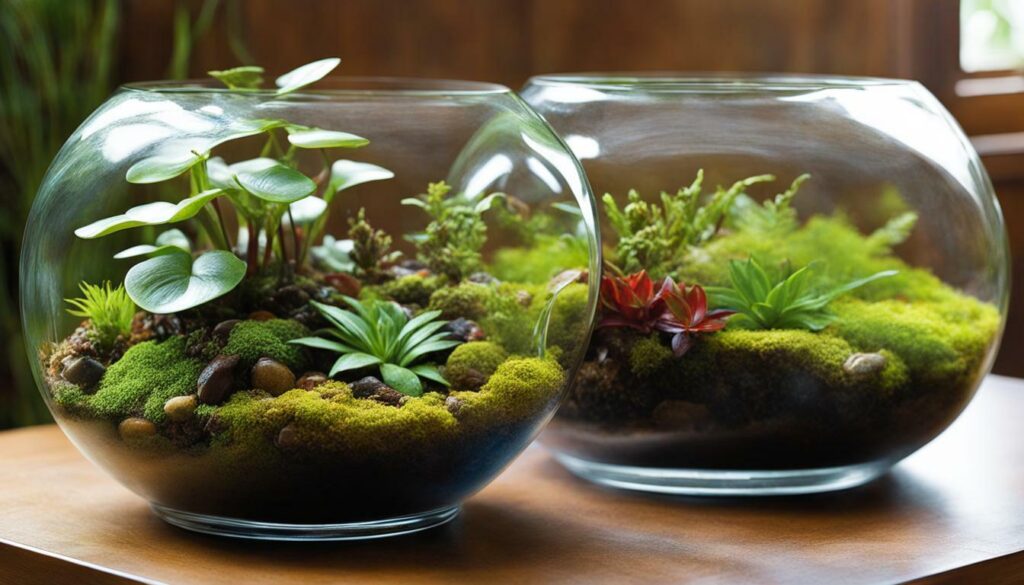
Preparing the Substrate and Water
Creating the ideal substrate and providing adequate water are essential for the successful growth of carnivorous plants in a terrarium. Unlike regular houseplants, carnivorous plants have specific soil and water requirements that mimic their natural habitats. To ensure optimal conditions for your terrarium, follow these guidelines:
Choosing the Substrate
When it comes to substrate selection, carnivorous plants thrive in a soil that is low in nutrients. This prevents them from relying on the soil for their nutritional needs and encourages them to obtain nutrients from their prey. A popular substrate option for carnivorous plants is a mix of sphagnum moss and sand. This combination provides excellent drainage and mimics the acidic, nutrient-poor conditions found in their natural habitats.
Providing Adequate Water
Carnivorous plants have a higher water requirement compared to other types of terrarium plants. To provide adequate moisture, consider using distilled or rainwater, as tap water often contains minerals that can harm these plants over time. It’s important to keep the substrate moist but not waterlogged. A good rule of thumb is to water the terrarium when the top inch of the substrate feels slightly dry to the touch. Ensure that excess water can drain properly by placing a layer of gravel or pebbles at the bottom of the container.
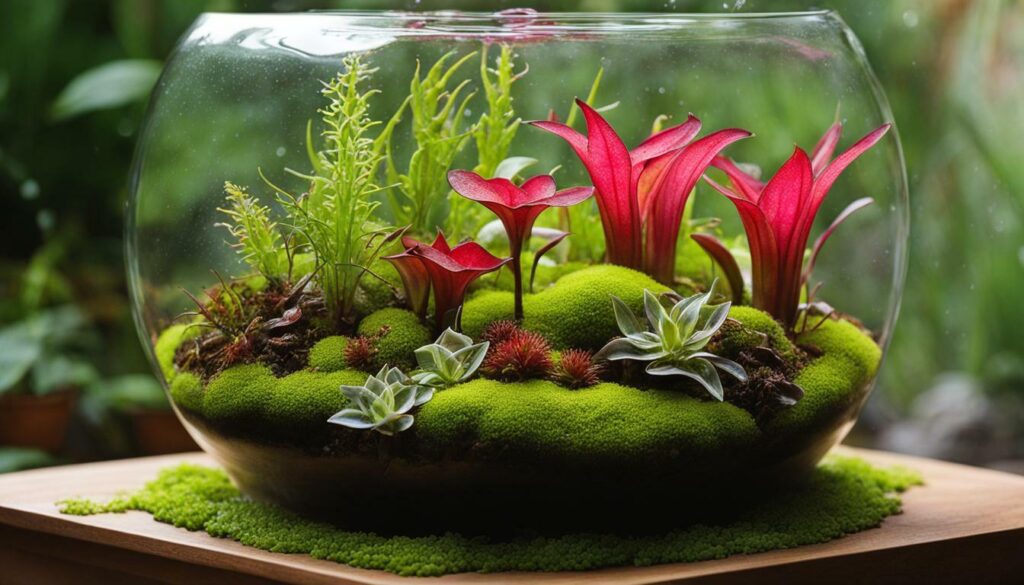
| Substrate Type | Pros | Cons |
|---|---|---|
| Sphagnum Moss and Sand Mix | Excellent drainage Resembles natural habitat conditions Encourages prey capture | May require periodic replacement Can be more expensive |
| Peat Moss and Perlite Mix | Good drainage Widely available Less expensive option | May compact over time May contain higher nutrient levels |
| Coconut Coir and Orchid Bark Mix | Retains moisture well No natural nutrients Sustainable option | Can be difficult to find May require additional amendments |
By carefully selecting the right substrate and providing adequate water, you can create a thriving environment for your carnivorous plants in a terrarium. These unique plants will not only add a touch of exotic beauty to your space but also serve as natural pest control, as they trap and consume insects. With proper care and maintenance, your carnivorous plant terrarium can be a fascinating and rewarding addition to your indoor garden.
Lighting Considerations
Adequate lighting is crucial for the health and growth of carnivorous plants housed in a terrarium. These unique plants have specific lighting requirements that differ from typical terrarium plants. Providing the right amount and quality of light is essential to ensure their well-being.
Carnivorous plants, such as sundews, pitcher plants, and butterworts, have evolved to thrive in environments with plenty of sunlight. They have adapted to obtain nutrients from insects and other small prey, which they capture using specialized structures. To support this unique feeding mechanism, these plants require bright, indirect light.
When setting up a carnivorous plant terrarium, it’s important to consider the positioning of the light source. Placing the terrarium near a window where it can receive several hours of indirect sunlight each day is ideal. However, if natural light is limited, artificial lighting can be used as a supplement.
Choosing the Right Artificial Light
“Artificial lighting can be an excellent solution for providing sufficient light to carnivorous plants in a terrarium.”
When selecting artificial lighting for carnivorous plants, it’s important to choose a light source that emits the appropriate spectrum. Full-spectrum fluorescent lights or LED grow lights are commonly used for terrariums. These lights provide a balanced spectrum of light, including the red and blue wavelengths that are essential for plant growth.
In addition to the spectrum, the intensity and duration of the light are also important considerations. Carnivorous plants typically require around 10-12 hours of light per day. To replicate the natural day-night cycle, it is recommended to use a timer to automate the lighting schedule.
Summary
In summary, the lighting requirements of carnivorous plants in a terrarium are unique and must be carefully considered. Adequate lighting, whether from natural or artificial sources, is crucial for their health and growth. With the right lighting setup, these captivating plants can thrive in a terrarium environment and provide a fascinating addition to any plant collection.
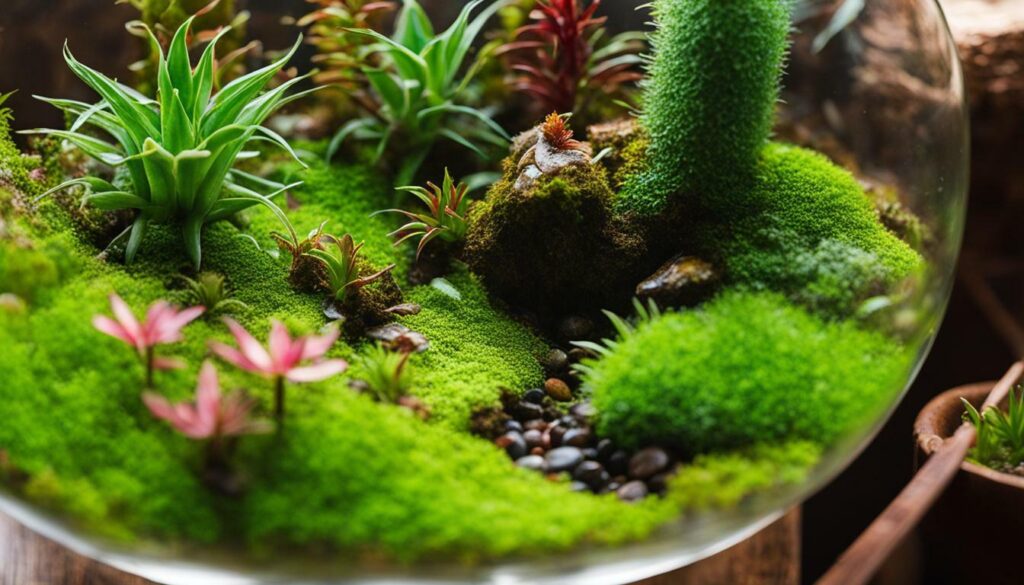
Choosing the appropriate carnivorous plants is key to creating a thriving terrarium ecosystem. These unique and captivating plants add a touch of intrigue to any terrarium setup. Popular carnivorous plants suitable for a terrarium include sundews, pitcher plants, and butterworts. Each of these plants has its own unique characteristics and care requirements, making them an exciting addition to your collection.
Sundews, with their glistening, sticky tentacles, are known for their ability to trap insects. These plants are perfect for terrariums as they thrive in humid environments. Pitcher plants, on the other hand, have modified leaves that form a pitcher-like structure, filled with a digestive fluid that attracts and consumes insects. Butterworts are another fascinating carnivorous plant with colorful and sticky leaves that ensnare unsuspecting prey.
It’s important to consider the specific care requirements of each plant before adding them to your terrarium. While some carnivorous plants are more forgiving and adaptable, others have more specific needs. For example, the Venus Flytrap and American Pitcher Plants require a period of dormancy, which may not be suitable for a terrarium setup.
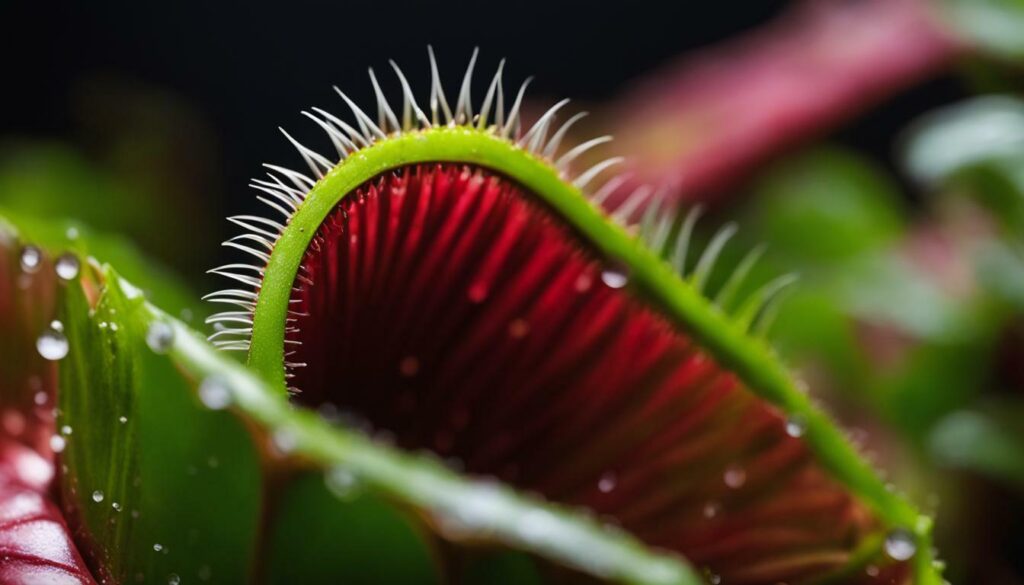
| Plant | Care Requirements |
|---|---|
| Sundews | Thrives in high humidity, requires bright indirect light, prefers distilled water or rainwater, needs moist soil |
| Pitcher Plants | Requires high humidity, needs bright indirect light, prefers distilled water or rainwater, thrives in acidic soil |
| Butterworts | Thrives in moderate humidity, requires bright but indirect light, prefers distilled water or rainwater, needs well-draining soil |
When choosing carnivorous plants for your terrarium, consider their care requirements, growth habits, and the overall conditions of your terrarium setup. This will ensure that your plants not only survive but thrive, creating a miniature world of wonder within your terrarium.
Setting Up Lighting
Properly setting up the lighting in your carnivorous plant terrarium is vital for their overall health and well-being. Carnivorous plants, such as sundews and pitcher plants, have higher light requirements compared to other plants typically found in a terrarium. They have evolved in environments with direct sunlight, so replicating these conditions indoors is essential for their long-term success.
When it comes to lighting, there are a few key factors to consider. First, the intensity of light is crucial. Carnivorous plants thrive in bright, indirect light, so placing your terrarium near a south or west-facing window is ideal. If natural sunlight is not sufficient or available, you can opt for artificial grow lights specifically designed for plants. These lights should provide a spectrum that closely resembles natural sunlight.
Additionally, the duration of light exposure is important. Carnivorous plants generally require 10 to 12 hours of light per day. You can use a timer to ensure a consistent and appropriate lighting schedule for your terrarium. Experiment with the placement and distance of the light source to achieve optimal light coverage without causing overheating or burning of the plants.
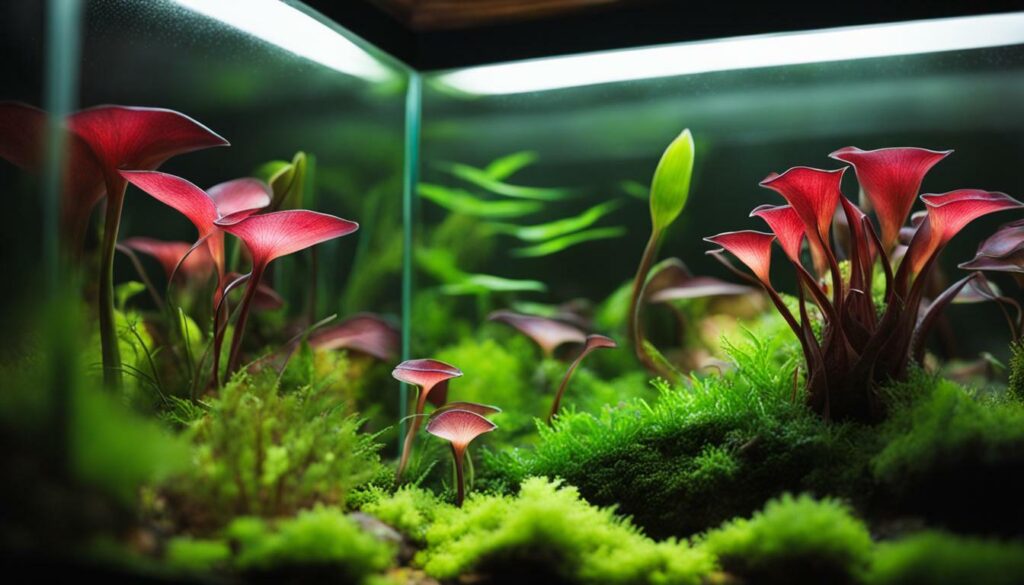
| Plant | Lighting Needs |
|---|---|
| Sundews | Bright, indirect light |
| Pitcher Plants | Bright, indirect light |
| Butterworts | Bright, indirect light |
By providing adequate and appropriate lighting for your carnivorous plant terrarium, you can ensure that the plants receive the energy they need for photosynthesis and proper growth. Remember to monitor their response to the lighting conditions and make adjustments as necessary. With the right lighting setup, your carnivorous plants will flourish and become captivating additions to your terrarium.
Maintaining the Terrarium
Regular maintenance is crucial to ensure the long-term success of your carnivorous plant terrarium. These unique plants require specific care and attention to thrive in this controlled environment. By following a few key steps, you can keep your terrarium healthy and vibrant.
Feeding and Cleaning
Carnivorous plants have adapted to survive in nutrient-poor environments by capturing and digesting insects. While they can obtain some nutrients through photosynthesis, they rely on insects to supplement their diet. In a terrarium setting, it is important to provide proper nutrition for your plants. This can be done by feeding them small insects, such as fruit flies or gnats, on a regular basis.
In addition to feeding, regular cleaning is essential to prevent the buildup of decaying insects and debris. Dead insects can attract mold or harmful bacteria, which can be detrimental to the health of your plants. Remove any dead insects or plant matter using tweezers or a soft brush. Keep the terrarium clean and free from any excess moisture, as stagnant water can also lead to mold or fungus growth.
Monitoring Plant Health
Observing the health of your carnivorous plants is an important part of the maintenance routine. Look out for any signs of stress or disease, such as wilting leaves, discoloration, or insect damage. If you notice any issues, take appropriate action to address them promptly. Depending on the specific plant species, this may involve adjusting the lighting, humidity levels, or watering frequency.
It is also important to monitor the growth of your plants. Some carnivorous plants may need periodic pruning to encourage new growth and maintain their desired size and shape. Remove any dead or overcrowded leaves to promote airflow and prevent the development of fungal diseases.
Summary
Maintaining a carnivorous plant terrarium requires regular feeding, cleaning, and monitoring of plant health. Providing proper nutrition and a clean environment will help your plants thrive. By observing their growth and addressing any issues promptly, you can enjoy the unique beauty of these fascinating carnivorous plants for years to come.
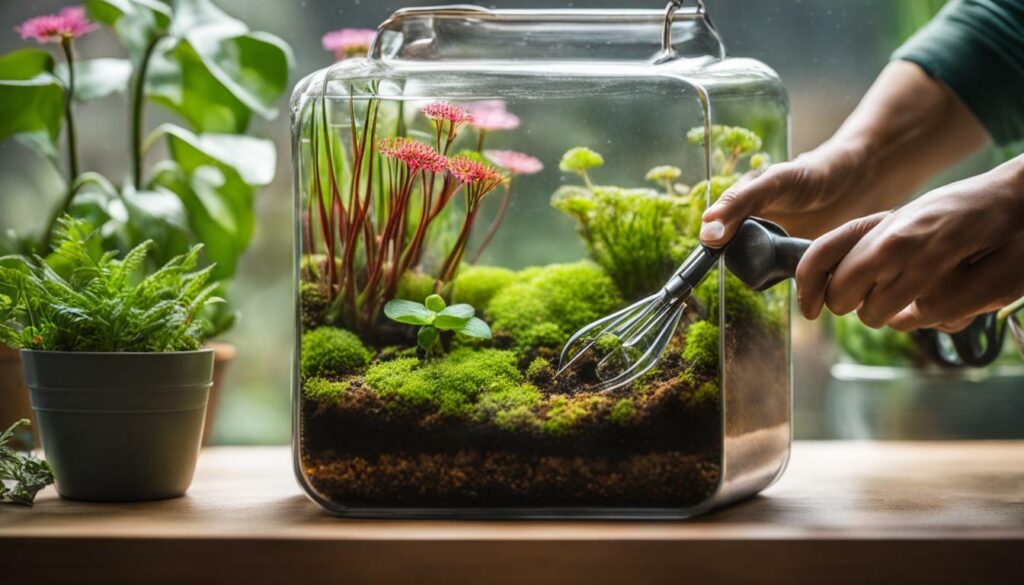
By exploring the world of terrarium plants and incorporating carnivorous plants into your green space, you can create a truly unique and captivating display. Carnivorous plants, such as sundews, pitcher plants, and butterworts, add an element of intrigue and fascination to any terrarium.
When setting up a carnivorous plant terrarium, it is important to choose the right container that provides proper drainage. Additionally, these plants require a specific soil substrate that is low in nutrients to mimic their natural environment.
Lighting is another crucial consideration for carnivorous plants in a terrarium. These plants typically require more light than regular terrarium plants, so it is essential to provide sufficient light to support their growth.
While some carnivorous plants, like the Venus Flytrap and American Pitcher Plants, may not be suitable for terrariums due to their specific care requirements and dormancy periods, there are still plenty of options available to create a stunning and thriving carnivorous plant terrarium. Regular maintenance, including feeding and cleaning, will ensure the health and longevity of your terrarium plants.
Can Foliage Plants and Carnivorous Plants Thrive Together in a Terrarium?
Yes, lush foliage plants for terrarium can coexist with carnivorous plants. Both require a humid environment and filtered sunlight. Carnivorous plants rely on insects for nutrients, while lush foliage plants thrive on the water and high humidity provided by the terrarium. With proper care, they can create a balanced ecosystem.
FAQ
Are all carnivorous plants suitable for terrariums?
No, while many carnivorous plants can thrive in a terrarium, some species like the Venus Flytrap and American Pitcher Plants have specific care requirements and dormancy periods that may make them unsuitable.
What kind of container should I use for a carnivorous plant terrarium?
It is important to choose a container that provides adequate space for the plants’ growth. Opt for a container with good drainage and a tight-fitting lid to maintain humidity.
What kind of soil substrate do carnivorous plants need in a terrarium?
Carnivorous plants require a low-nutrient soil substrate in a terrarium. Use a mix of sphagnum moss, sand, and perlite to create the ideal substrate for their growth.
How much lighting do carnivorous plants need in a terrarium?
Carnivorous plants typically require more light than regular terrarium plants. Provide them with bright, indirect light for about 10-12 hours a day. Consider using artificial grow lights if natural light is insufficient.
How do I select the right carnivorous plants for my terrarium?
Consider the care requirements and growth habits of different carnivorous plant species. Choose plants that are suitable for the lighting and humidity levels you can provide in your terrarium.
How do I set up lighting for a carnivorous plant terrarium?
Position the lights above the terrarium at a height that provides optimal light intensity. Use timers to ensure the plants receive the required amount of light each day.
How do I maintain a carnivorous plant terrarium?
Regularly feed your carnivorous plants with appropriate prey like insects. Keep the terrarium clean by removing any dead plant matter or trapped prey. Monitor the plants’ health and make any necessary adjustments to their care.

